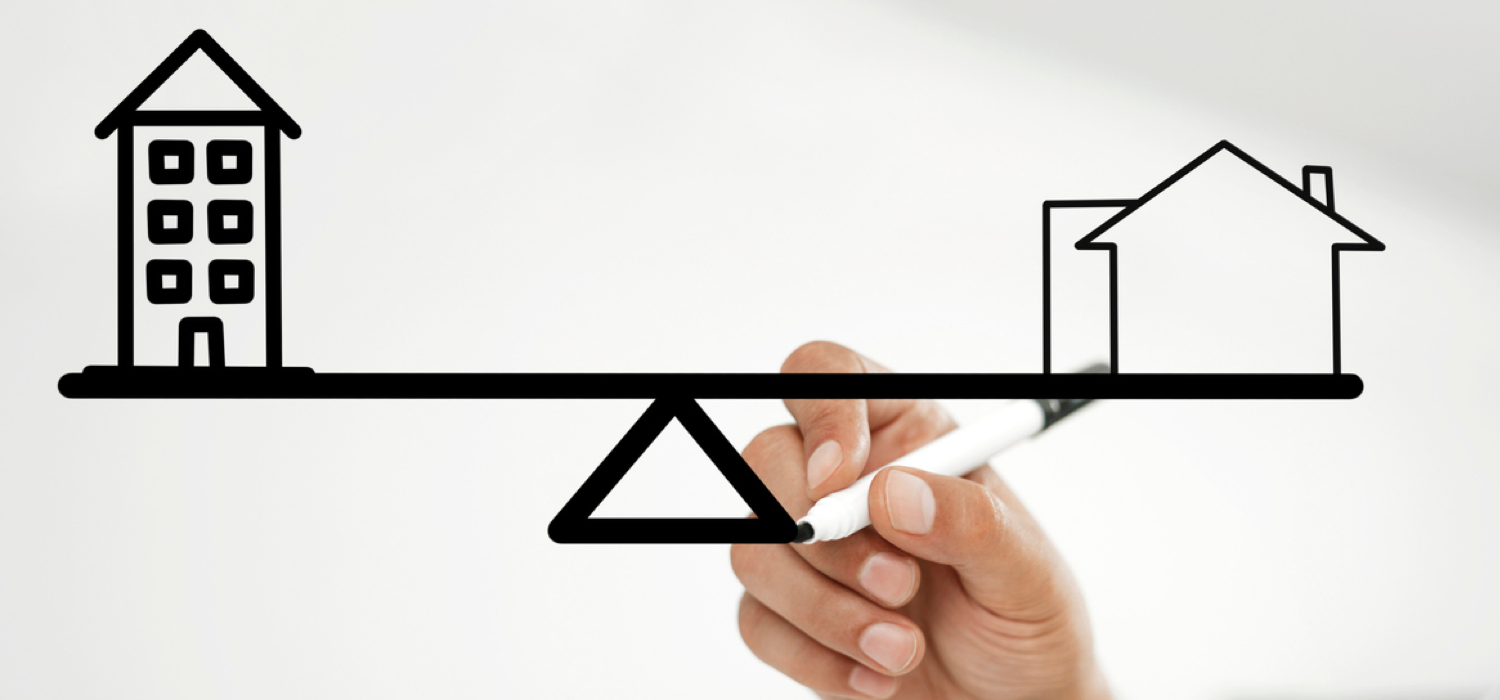Should you invest in single-family rental properties or multifamily rental properties? When it comes to residential real estate, this is the debate among new and seasoned investors alike.
While you can sift through juxtaposing opinions in online forums until you’re blue in the face, at the end of the day it simply boils down to your personal criteria and investing goals.
In this article, we’ll analyze single-family rental (SFR) versus multifamily rental (MFR) properties, so you can choose the best route for you.
Advantages of single-family rentals
1. Less expensive to get started
One of the biggest advantages of SFR properties for novice real estate investors is that they cost less and require less capital upfront. While you can still find quality, cash-flowing rental homes for under $100,000 in the Midwest and South, even a small multifamily building could easily cost well over a million dollars (depending of course on how many units there are and which market you’re buying in).
The higher price tag on multifamily properties means a lot of other things are going to cost more as well.
Conventional lenders typically require a down payment of at least 20% for residential real estate loans. So for a $100,000 property, you’d only need to put down $20,000.
Alternatively, if you’re hoping to finance a multifamily property with more than four units, you’ll likely need to seek funding via a commercial real estate loan. (Loan terms for two- to four-unit properties vary little — if at all — from those for single-family homes.) Commercial lenders typically require a 25-30% down payment for apartment buildings. While this is only 5-10 percentage points higher, the increase equates to a substantial chunk of change. Translation: For a $1 million property, you’d need to have at least $250,000 for the down payment alone.
Additionally, most lenders require investors to have cash reserves to cover at least six months of payments for SFRs, and anywhere from 6-12 months for multifamily properties. Again, because an MFR property’s value is typically much greater, the necessary cash reserves are likely to be higher — even if the minimum time period (in this case, six months) is the same.
Further upping the entry costs, commercial real estate loans involve higher interest rates (typically 2-2.5% higher on average) and less attractive terms. There are also fewer banks to choose from, due to a smaller secondary market for the mortgagee to sell the loans.
Lastly, lenders also require additional qualifications for commercial real estate loans. Along with your personal income information and business tax returns, you’ll need to provide the property’s operating statements for the last two years and rent roll. Many lenders also require that you have some prior property management experience.
→View single-family rental properties listed for sale on our marketplace
2. Greater resale opportunities
Of course, the flipside to SFRs being easier to buy is that they’re also easier to sell — but not just because of their comparatively lower price tag and lower barrier to entry. Since you can sell to both real estate investors and traditional homebuyers, single-family homes have a much larger buyer pool than apartment buildings and duplexes.
3. Growing demand
Single-family rentals are the fastest-growing segment of the U.S. housing market, outpacing both single-family home purchases and multifamily housing. Real estate experts predict this growth in the SFR market will only increase in the coming years.
According to U.S. Census estimates reported on RENTCafé, the number of single-family rentals in the U.S. grew by 31% in the decade immediately following the housing crisis (2007 to 2016), while multifamily rentals grew by only 14%.
Student loans, credit card debt, and wage levels that lag behind the cost of living make it difficult for many potential homebuyers to afford a house. For this segment of the population, single-family rentals have become an attractive alternative.
Adding to the demand, most millennials are entering the age range when people tend to start having kids, and the desire for a single-family home increases. The Urban Institute forecasts that the economic pressures listed above will drive many to opt for a rental home.
Adding to the upsides, SFRs traditionally experience less tenant turnover compared to MFR. This can represent considerable cost-savings when factoring in rehabbing and re-leasing costs.
4. Easier to diversify
Rental markets fluctuate regionally. One city could be celebrating a boom in new businesses while another is struggling with the aftermath of a factory closure. If you’ve poured everything into a 10-unit apartment building and the local market takes a downturn, you may be harder hit than if your investments were spread out among several different SFR homes in various parts of the country.
And because SFRs have a larger buyer pool and generally cost far less than MFRs, it may be easier to cut one loose and reinvest elsewhere if the need arises.
5. Lower tenant turnover
Tenant turnover costs time and money. Every time someone moves out, you (or your property manager) has to coordinate cleaning, repairing damages and general wear and tear, marketing and showing the listing, and screening applicants. And, of course, there’s the loss of rental income while the unit sits vacant.
This brings us to our fifth upside for SFRs: They traditionally experience less frequent vacancies and tenant turnover compared to MFR, which represents considerable cost-savings when factoring in rehabbing and re-leasing costs. The average SFR tenant stays for three years — roughly double the average apartment resident’s tenure. And SFR tenancies of five or six years are not unusual.
Financial pressures may be keeping many renters of single-family properties out of the buying market, but they’re still eager to grow roots. This means SFR tenants tend to think of the rental property as their own home and behave as such.
Among young adults, renters of single-family homes have always tended to move less often than apartment renters. And single-family home rentals is one of the fastest growing market segments. - Zillow
Adding to that stability, many SFR tenants have kids and are reluctant to yank them out of school for another move. According to data from John Burns Real Estate Consulting, 52% of SFR renters are families, compared to only 30% of MFR renters, who are far more likely to be under 35 or over 65.
Advantages of multifamily properties
1. Scale faster
Say you want to grow your real estate portfolio by 10 units. With single-family rental properties, you’d have to find 10 separate houses. That’s 10 different sellers, 10 different inspections, and potentially 10 different mortgages. Purchase a 10-unit apartment building, however, and just like that — you’re now the proud owner of 10 rental units. Lenders might want to take a closer look under your financial hood when you’re trying to close on an MFR, but it’s potentially a lot less hassle compared to investing in an equal number of SFR units.
→View 2-4 unit rental properties listed for sale on our marketplace
2. Beneficial economies of scale
Continuing with the example of our 10-unit apartment building from above, there are other upsides to having all 10 units under one roof. Fix that one roof — or any other part of the building or common area — and you’ve effectively repaired all 10 units. Not only does this cost far less than renovating 10 single-family rentals, it also increases the value of all 10 at once.
Economies of scale, or reduced costs per unit, will work to your benefit in myriad issues. You only need one insurance policy. Landlords of these properties only have to drive to one location for showings, inspections and routine maintenance issues. If you hire a property management company, you only have to find and interface with staff from one company, compared to multiple if you owned several single-family rentals in different states.
On top of that, most property management companies charge less per unit to manage multifamily rentals — typically 4-7% of the monthly gross income compared to 10% on SFRs. Want to replace the plumbing or all the windows on an apartment building? Most contractors will typically offer a better per-unit rate compared to doing the same work on individual SFRs.
3. Higher monthly cash flow
Unless you own multiple SFRs, an MFR will typically translate into higher rental income.
MFR owners are also far less likely to get hit with zero rental income. If a tenant moves out of a single-family rental, it is 100% vacant. Alternatively, if a 10-unit MFR loses a tenant, it’s only 10% vacant. Even after that reduction in cash flow, you’ll still have 90% of your regular monthly rental income to cover the property’s mortgage and operating costs.
There are a few things to keep in mind, however:
First, higher monthly cash flow does not equate to “better return on investment.” Yes, there are more renters sending you checks each month with a multifamily property. But monthly net cash flow is just one part of the equation when it comes to overall return.
Second, remember that more tenants = more wear and tear. As the property ages, an increasing amount of your rental income may go towards general maintenance and upkeep costs.
4. *Sometimes* easier to finance
As we mentioned earlier, some lenders have a more rigorous approval process and higher rates for multifamily loans.
However, financing is complicated and individual circumstances can vary wildly — especially when you’re talking about a category as broad as multifamily properties. That said, in some cases it may be easier to obtain a loan for a million-dollar apartment building than a single-family rental home. Why? Cash flow.
Since it’s unlikely that an MFR’s cash flow would totally dry up, the risk of foreclosure is lower. Depending on how everything else checks out, in some cases a multifamily property may be a safer proposition for lenders. And because an MFR’s value is based off the income it generates (whereas an SFR’s value fluctuates with the real estate market), you may be able to secure more flexible financing and better terms on a profitable property.
5. You can live there too
For many new investors, “house hacking” is one of the biggest advantages of owning a multifamily investment property. If you don’t mind living in one of the units, you can avoid paying rent somewhere else or having a second mortgage on a separate primary residence.
The benefit can be even greater for those who plan to live in a two- to four-unit MFR. These smaller multifamily buildings still qualify for many owner-occupied, low down payment financing options, including government-backed FHA and VA loans. Borrowers can apply for FHA loans with down payments as low as 3.5% and VA loans with 0 down.









